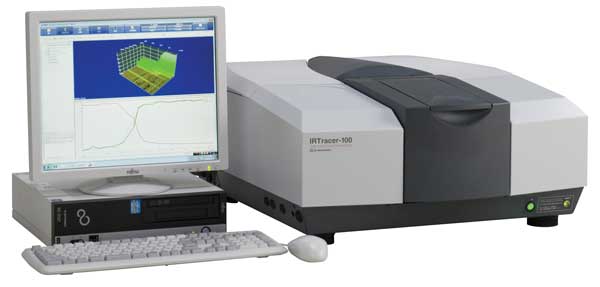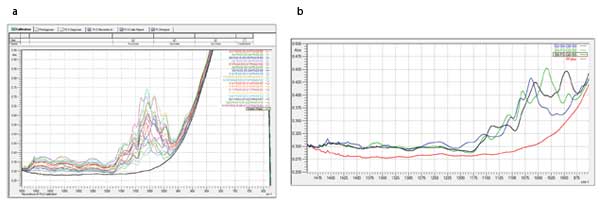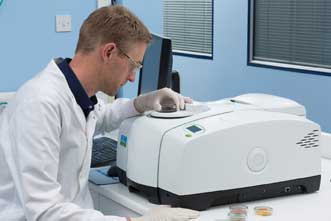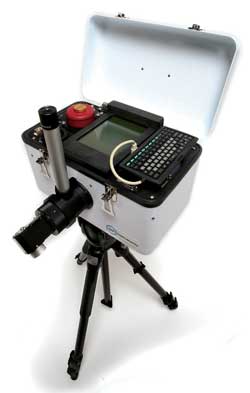Innovative techniques and improvements in instrumentation are expanding the potential of Fourier transform infrared spectroscopy in bio applications and many other fields.
Fourier transform spectroscopy (FTS) allows researchers to acquire spectra of solids, liquids and gases across a wide spectral range. The field of FTS is broadening as new techniques appear and commercial instrumentation becomes more sophisticated. Applications are evolving to include astronomy and planetary science, atmospheric and environmental remote sensing, pharmaceutical research and quality control, and all types of chemical and molecular laboratory spectroscopy.
The “Fourier transform” moniker originates from the use of a mathematical Fourier transform function to convert data into the frequency domain to create the actual spectra. Unlike dispersive spectrometers that use diffraction gratings or prisms to measure intensity over a short range of wavelengths, FTS can quickly acquire multiple spectra using an interferometer and a large, circular aperture without an entrance slit. The bigger opening of an FT spectrometer combined with the interferometer enables simultaneous collection of more spectral data such as absorption, emission, photoconductivity or Raman scattering in one sweep with high optical throughput. With more spectral information entering the instrument, the biggest benefit of FTS is higher signal-to-noise ratio (SNR).
The IR version of FTS, called FTIR, is particularly useful in bio applications, where vibrational motions between molecules create “fingerprints” that help identify specific chemicals and constituents. Well-established in the commercial market, FTIR spectrometers have recently seen improvements resulting from advances in optics as well as in software that enables better calibration and data-processing algorithms.

Figure 1. The IRTracer-100 from Shimadzu generates up to 20 FTIR spectra per second, which enables monitoring of reactions like curing, kinetics and molecular interactions in applications including pharmaceuticals, foods, chemicals and electronics. Courtesy of Shimadzu.
Commercial FTIR
Commercial FTIR spectroscopy instruments in the optimal “middle of the value chain” are those that can obtain from two to 20 spectra per second with SNRs of up to 60,000:1 – Shimadzu’s IRTracer-100, for example (Figure 1). But sample acquisition time and SNR work against each other. A higher SNR needs either a longer scan time or carefully controlled low levels of background noise.
“The interesting thing about FTIR is you’re measuring heat energy,” said Mark Talbott, product manager at Shimadzu Scientific Instruments of Columbia, Md. “Heat from nearby lamps or even a breath can affect the spectrum. Background noise can come from an AC vent or nearby window. This can be a problem if you have a sample with a minor contaminant that’s hard to see.” To reduce noise, some commercial FTIR machines provide algorithms in the software that automatically subtract atmospheric water vapor and carbon dioxide from the sample spectrum in less than a second. The resulting spectra can distinguish vapor accidentally introduced into the sample chamber from liquid water in the sample itself (Figure 2).

Figure 2. The IRTracer-100 from Shimadzu measures the spectrum of training-matrix aqueous sugar standards (a), and 5 percent aqueous solutions of water (red), fructose (blue), glucose (green) and sucrose (black) in baby food (b). Macros including Pharma Report, Food Additive Identification and Contaminant Analysis help streamline analysis time. Courtesy of Shimadzu.
Many pharmaceutical applications use FTIR spectroscopy to identify an extremely small black speck of a contaminant in a light-colored tablet (Figure 3). A typical microscope can mask down an area measuring 3 × 3 µm, which is then compared to libraries of known spectra. Instrumentation has evolved to include advanced software that can perform de-convolution or curve fitting. However, to compare spectra to those from a library, high-quality spectra are required to begin with.
A common resolution limit (measured by the full-width half-maximum of a spectral feature) in commercial FTIR instrumentation is 0.5 cm−1. Shimadzu’s IRTracer offers resolution of 0.25 wave numbers, which is useful for analyzing gas samples that require identification of narrow vibrational bands representing different energy states. Vapor in the gas phase has more vibrational states and fine structure than water in the liquid phase, so it becomes harder to identify. Very large and expensive research-grade instruments costing upward of $100,000 can reach resolutions as small as 0.05 cm−1.

Figure 3. Software algorithms like those in the PerkinElmer Frontier FTIR instrument automatically subtract atmospheric water vapor and carbon dioxide from the sample spectrum, helping to decrease background noise in the lab. Courtesy of PerkinElmer.
Imaging FTSThe technique of combining imaging and FTIR is growing in several applications.
“FTIR imaging is the next big thing,” Talbott said. “Bio researchers are looking for functionality in O-H groups and N-H stretches. With an instrument like our AIM-8800 FTIR microscope, they can scan a very small sample to get something like an SEM image that also reveals the concentration of details such as carbonyl peaks, double bonds, amides and phosphate stretches in the sample.”
Whereas traditional IR spectroscopy generally provides a single spectra containing spatially averaged information over the entire sample area, imaging FTIR enables users to gather both cumulative and localized information about a sample. For example, a typical FTIR instrument with a spot size of 8 mm in diameter takes one reading over that spot to generate a single spectrum.
“If, instead, you break down that area into many smaller points and obtain a spectrum at every point,” said Jerry Sellors, IR Business Manager at Perkin-Elmer of Seer Green, England, “you get information about the distribution of chemical species across that area.” Such a multipoint reading enables instruments like PerkinElmer’s Spotlight 400 FTIR imaging system to build up images of the distribution of specific chemical entities within a sample. This can provide deeper insight into the structural composition and makeup of the target.
Imaging FTIR technology is very helpful in pharmaceutical applications, such as quality control and anticounterfeiting. While difficult to quantify, some estimates place 5 to 8 percent of the world’s total pharmaceutical sales as counterfeit or of dubious quality (a value that varies greatly from country to country).
Traditional spectroscopic techniques such as high-performance liquid chromatography and NIR spectroscopy cannot differentiate between genuine and counterfeit products. Both of these techniques work at the macro level, so they aren’t precise enough to distinguish concentrations of ingredients.

Figure 4. The Spectrum Two FTIR spectrometer from PerkinElmer is a highly transportable instrument with numerous applications in pharmaceutical analysis, hydrocarbon environmental monitoring, quality assurance of nutraceuticals (nutritional supplements and natural health products), water safety and fuel analysis. A robust design enables users to run samples in the field. Courtesy of PerkinElmer.
Imaging with FTIR combines high sensitivity and rapid imaging to large sample areas at high spatial resolution – up to 3 µm at 1000 cm−1 for the Spot-light 400 – when combined with the proprietary ATR imaging accessory; the latter comprises a Cassegrain-style antireflection-coated reflective objective and a high-refractive-index germanium ATR crystal. This high-resolution FTIR imaging technique extends IR microscopy into new application areas such as the study of biomaterials like tissue, bones and leaves.
In the research arena, FTIR imaging is uncovering new ways to look at clinical diagnostics. Klaus Gerwert and colleagues at Ruhr University Bochum in Germany recently demonstrated an FTIR imaging approach called spectral histopathology, which combines FTIR and Raman vibrational spectroscopy systems. The label-free spectral histopathology system automatically discriminates tissues, demarcates cancerous areas and detects characteristic marker patterns in the spectra of body fluids, according to an article the team published in SPIE Newsroom in January (doi: 10.1117/2.1201312.005297). Using the method, the team identified cancerous colorectal tissue in 14 classes, including cancerous lesions and precancerous states, without staining. The group hopes that the method will eventually reach clinical application, where it would reduce the need for special pathology expertise.

Figure 5. The Model 102 mobile FTIR spectrometer from D&P Instruments of Simsbury, Conn., is built into a single handheld enclosure weighing about 7 kg (15 lb). The system includes an interferometer, a liquid nitrogen detector and a computer with a miniature LCD screen and keyboard. An AC power supply and battery charger allow it to be run with a vehicle cigarette lighter. Courtesy of Win Wadsworth/D&P Instruments.
Making FTIR instrumentation mobile is another area of focus in commercial systems (Figure 4). For convenience in both the field and laboratory, modular systems can be handheld or contained in a portable case with a tripod. Some nimble units can be powered via vehicle cigarette lighters (Figure 5). A system much like the one featured in Figure 5 was used by Andreas Eisele at GFZ German Research Center for Geosciences in Potsdam, Germany, and colleagues to predict soil properties across semiarid regions of the Australian wheat-belt region (Remote Sensing, doi: 10.3390/rs4113265). A transportable system makes large-scale measurement of soil properties practical, and can help scientists address a range of global issues from food production and climate change to environmental degradation.
Software
Manufacturers agree that software can really set apart FTIR systems from other IR spectrometry instrumentation. In pharmaceutical applications as well as other areas, the big challenge currently is to create sophisticated software that is easy to use and that facilitates fast and cheap data collection, processing and result generation.
“You want very high signal-to-noise and very rapid scanning for monitoring reactions, but having macros that rapidly analyze a library really streamlines the process to give accurate results quickly,” Talbott said.
Highly configurable software like Spectrum Touch in PerkinElmer’s Spectrum Two FTIR means that customers can formulate the operation specifically for a given application, so inexperienced or occasional users can get answers more easily than they could using general-purpose FTIR software.
“This can significantly impact productivity and quality of results,” Sellors said.
Above all, commercial manufacturers are striving more than ever to make FTIR instrumentation user-friendly. “Quality
isn’t always about signal-to-noise or resolution specifications,” Sellors said. “Getting the right training and support to ensure the most appropriate sampling is employed, and that instrument settings and data analysis are correctly specified, can be the difference between success and failure.”
Reference
1. Fortin et al (Sept. 27, 2013). LWIR polarization sensing: investigation of liquids and solids with MoDDIFS. Proc SPIE 8873, Polarization Science and Remote Sensing VI, 88730H; doi: 10.1117/12.2023328.